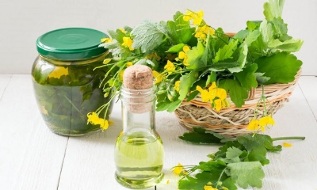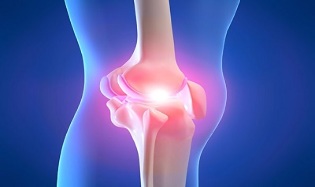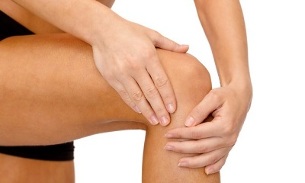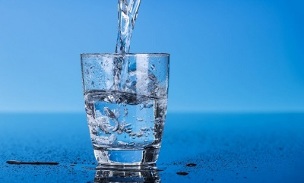Thousands of people, especially after the age of fifty, suffer from various forms of diseases of the musculoskeletal system. This has a significant impact on quality of life, imposing many restrictions and causing significant pain.
Osteoarthritis of the knee joint, called gonarthrosis, is rightly considered one of the leaders on the list of the most common causes of disability in the ranks of the adult population of Russia. However, you should not think that you are not threatened by this disease in your youth: you can leave the doctor's office with the inscription "gonarthrosis of the knee joint" on the card long before retirement.
The concept and causes of osteoarthritis of the knee
Osteoarthritis is nothing but a destructive change in the cartilage tissue, ie its destruction, exhaustion, followed by a decrease in the volume of synovial fluid.
This can be for many reasons:
- Delayed injuries and constant stress on the joints, exhausting physical work;
- Hereditary factors;
- Metabolic disorders;
- Overweight;
- Poor diet, lack of essential vitamins and minerals.
Stages of osteoarthritis of the knee joint
Doctors distinguish three stages of osteoarthritis of the knee:
- Signs of the first stage are short-term pain that occurs after exertion and passes quickly enough during rest. The pain is dull, painful. From the outside the joint looks healthy, the only thing that can be noticed at this stage is a slight swelling;
- In the second stage, the pain syndrome is characterized by greater strength and duration. Patients notice a certain stiffness of the joint in the morning, cramping when moving the knee. Certain movement restrictions are possible, the joint increases in volume;
- In the third phase there is a significant limitation of mobility, constant severe pain, severe joint deformity.
Unfortunately, at the first signs of illness, almost no one sounds the alarm. As a result, people come to specialists with already advanced arthrosis, when much more complex treatment is needed.

Osteoarthritis of the knee with a delayed diagnosis and lack of appropriate therapy can have very serious consequences, up to complete immobility of the affected leg, when movement in a crutch-free space becomes completely impossible.
In the most advanced cases, the only way out is an operation during which an artificial joint is installed.
These operations are complex, expensive, and can be complex.
That’s why it’s so important not to ignore knee pain and not to delay a visit to the doctor.
Treatment of osteoarthritis of the knee with alternative methods
In order to beat gonarthrosis, a complex therapy is important: a combination of medications prescribed by an expert and folk remedies for osteoarthritis of the knee.
Traditional methods of treating osteoarthritis of the knee give a pretty good effect, especially in the initial stages of the disease. Their use at least relieves pain, and maximally allows you not to lead to expensive surgeries.
Also, one should not lose sight of the fact that this disease is chronic and therefore requires constant attention. Modern experts attribute osteoarthritis of the knee to incurable progressive diseases.
Accordingly, most treatments consist of continuously taking certain medications to relieve pain and reduce the inflammatory process. However, taking medication intermittently for a long time is harmful. That is why it is so important for people suffering from gonarthrosis to be able to work with folk methods, at least during the period of remission.
So let’s find out what is an alternative way to treat osteoarthritis of the knee. Experience in combating this disease dates back hundreds of years, so the list of medications that can be used at home is very extensive. For greater comfort, all folk remedies for the treatment of osteoarthritis of the knee joint can be divided into four groups.
Medicinal herbs

The first group includes herbs: burdock, onion, celandine, cabbage leaves, etc. Herbal treatment for osteoarthritis of the knee involves the use of self-prepared medications both inward and outward.
- Compresses of fresh horseradish root, cabbage or burdock leaves that need to be applied to a sore knee, insulated with cotton wool or several layers of bandage and left overnight, bring tangible relief. Previously, the cabbage leaves are crumpled or pounded for greater effect so that they release juice, and you can lightly grease the leaves with honey. Burdock leaves are dipped in boiling water for 30 seconds and then cooled. Horseradish root is chopped and slightly warmed;
- You can also use celandine: a few tablespoons of dried herbs should be boiled in boiling water and then cooled to 40-50 ° C. The resulting infusion is drunk before meals, and the remaining cooked celandine is placed as a compress;
- If the disease is in an early stage, ice medicine can be used. The ice pack is firmly attached to the sore spot with a woolen cloth and remains there until the ice melts. This compress is used when you need to quickly get rid of edema and stop the inflammatory process;
- Compresses are time consuming, so many people will find different rubs more appropriate. Rubbing is a liquid mixture of remedies that must be rubbed vigorously into the skin of the affected area. For the treatment of osteoarthritis are especially suitable rubbing from the roots of elekampana, aged vodka, tincture of chamomile, tincture of yellow dandelion head and sunflower oil. It is better to apply them on clean, ideally evaporated skin. It is necessary to rub the sore knee daily for 5-10 minutes, and then wrap it for a while with a towel or any warm cloth;
- Another proven recipe is a tincture of saber for the preparation of which 1-1, 5 tablespoons of herbs are poured with 100 ml of vodka and left. The resulting tincture is applied to the knee twice a day for a month;
- There is a recipe based on potato sprouts. They are washed, placed in a glass jar, poured with vodka and left out of light for three weeks. After this period, the infusion is filtered and the used germs are discarded;
- You can peel and chop the garlic head, pour 200 ml of vegetable oil over it and leave it in a dark place for a week. The tincture has a strong odor, this must be taken into account if you have to go somewhere soon after applying the rub. In this case, you should thoroughly wash the places where the tincture is inflamed;
- Many people notice the benefits of baths based on medicinal herbs: malt, hay plant and others. A pine bath gives a good effect. You can buy a ready-made coniferous collection at the pharmacy or prepare a decoction yourself. To do this, it is necessary to take young twigs of conifers with a total volume of approximately one liter, pour two or three liters of water and cook for about 10 minutes. Then the soup is filtered, the twigs are thrown and the liquid is poured into a bath with water. It should be bathed with herbs for 15 minutes.
The simplest is a salt bath. Three tablespoons of common or sea salt and the same amount of baking soda are poured into the basin with hot water, after which the painful knee is immersed in the basin for 15 minutes.
After bathing, the feet should be dried quickly and hidden under a warm cloth.
Self-prepared infusions are taken internally. They do not need boiling, dry herbs simply pour boiling water and keep to cool. Infusions are taken 2-3 times a day, half a glass. For the treatment of osteoarthritis of the knee, infusions of horsetail, spruce, young nettle and birch leaves are prepared.
A medicinal infusion of onion is very effective for pain: two medium-sized onions are poured over a liter of boiling water and insist, and the resulting liquid is consumed in three doses.

Another simple but effective recipe is cranberry tea. Pour a tablespoon of fresh or dried cranberry leaves with a glass of boiling water.
Like most infusions, this tea should be drunk half a cup twice a day during the month, preferably in the afternoon.The use of these decoctions helps to restore metabolic processes in the affected cartilage tissues, reduces the pain syndrome and promotes the removal of harmful compounds from the joint fluid.
Self-massage
Another popular folk remedy for osteoarthritis of the knee joint are self-massage techniques. Self-massage is very effective, although it does not require any costs other than temporary. Keep in mind that the knee must be prepared before the session! It is best to warm it under a warm shower or a gentle circular rub.
You can then go directly to the massage.
His main techniques are as follows:
- Circular palm strokes. We alternate the lungs, without pressing, stroking clockwise and clockwise, while affecting not only the knee itself, but also the adjacent areas. This technique reduces muscle tone and improves blood and lymph outflow from the area affected by osteoarthritis;
- Rubbing. We rub the knee in a circle, at the same time providing tangible pressure. It can be rubbed with the palm or a folded fist. This relaxes the muscles and improves joint mobility. Circular movements are most effective in the Turkish position if the condition of the knee allows such a position;
- Knee toes with moderate pressure. This technique allows you to have a beneficial effect on deeper structures.

Self-massage can be performed by bathing at a comfortable temperature. Some sources mention honey massage at night, but cream or a special ointment is usually used. You can make such an ointment yourself.
This requires adding a small amount of essential oil to a container of Vaseline. Rosemary oil has a positive effect on blood circulation, peppermint oil has a cooling and analgesic effect, and lavender oil helps stop inflammation.
The duration of the self-massage procedure is about 15 minutes, it can be performed 2 to 4 times a day. Only self-massage performed regularly will be effective. In addition, massage is useful as a preventive measure, in which case it will be enough to conduct it at least once a week.
You should not feel pain or discomfort during self-massage, otherwise you can only make the situation worse.
Rehabilitation gymnastics
The third remedy is remedial gymnastics. It also requires prior preparation, warming up, which can be used as a self-massage. Such a complex use of these two means has a positive effect on their effectiveness.
Here are three simple exercises:
- Sit on a table or high chair with your feet off the floor. Then just swing your legs from one side to the other, the swings should not be sharp, and the range of motion is too great. The duration of the exercise is approximately seven minutes;
- Sit in a comfortable chair with your knees bent at a right angle and your feet flat on the floor. The exercise can be performed with only one affected leg, but it is beneficial to use both legs not only when both knees are affected, but also for preventative purposes. Place your foot on your toes, lift your heel off the floor as much as possible, then lower it to the floor, then continue to repeat this movement at a leisurely pace for five minutes. It can be performed with two legs alternately or simultaneously;
- Take the same position as in the previous position, only now rest only on the heel. Tap the floor with your toes. The duration of the exercise is five minutes.
Some exercises can be done early in the morning while you are still in bed. They are a kind of exercise for the joints. One such exercise is exercise on a bicycle.
The second exercise is performed as follows: bend one leg and leave the other outstretched, pull the toes of the outstretched leg as far as possible towards you, and then change legs. Repeat several times. You can also alternately draw your legs to your chest and straighten up.
Power Adjustment
The fourth way to treat knee osteoarthritis at home is to adjust your diet. It is not enough to affect the body from the outside, it is necessary to compensate for the lack of substances needed to restore the structure of cartilage cells.
Therefore, you will need to change the usual menu: add some products and exclude some or reduce their use to a minimum.
The issue of nutrition is especially relevant for overweight people, because with gonarthrosis, excess weight further exacerbates the already poor condition of joint structures.
Let's start with a list of recommended products:

- Dairy products: cheese, cottage cheese, sour cream, kefir with a fat content not exceeding 3, 2%. They contain many proteins useful for cartilage regeneration;
- Millet, rice and buckwheat porridge, wholemeal bread. This food is rich in complex carbohydrates, without which the synthesis of synovial fluid is impossible. You should not buy instant porridge. They will not be useful, because cereals are processed for them in a completely different way than when cooking porridge at home, as a result of which most of the useful elements are destroyed;
- Dishes that contain gelatin: fish jelly, jelly meat, jelly, pudding. Gelatin enables the renewal of cartilage cells due to the high content of collagen and chondroitin;
- Any fruits and vegetables, because they contain a lot of fiber. Greens, carrots, beans, celery, radishes and cauliflower are especially helpful;
- Steamed or steamed meat and fish, especially in combination with vegetables;
- Sprouted wheat;
- Nuts: hazelnuts, pine nuts and almonds.
In order to better absorb healthy food, it is recommended to consume two glasses of mineral water a day.
Let's go to the list of harmful products:
- Salt and spices. They cannot be completely eliminated from the diet, however, to combat joint disease it is worth limiting their use. This rule does not apply to turmeric: its use, on the contrary, is considered useful. Turmeric has been shown to have a positive effect on cartilage tissue, contributing to its growth and recovery;
- Any fatty, smoked and sour dishes;
- Semi-finished products;
- Fast food and carbonated drinks;
- Alcoholic beverages: even a small amount of alcohol slows down metabolic processes, which negatively affects the regeneration process;
- Confectionery and flour products. They are full of simple carbohydrates that can trigger weight gain. As mentioned above, being overweight puts extra strain on joints that are already weakened by osteoarthritis;
- Coffee. This drink can be consumed, but only in small amounts, otherwise calcium will be flushed out of the body;
- Peppers, cabbage and tomatoes, which block collagen, preventing the regeneration and growth of cartilage tissue;
- Citrus and cherry. Due to their high acid content, their use adversely affects bone structure.
To make the most of this diet, don't forget to drink enough water: at least 1. 5 liters a day. The daily calorie intake should not exceed 3000, and the food should be at room temperature, in no case hot.
Remember that treating osteoarthritis of the knee is a long process, and how successful it will be depends on your willingness to regularly perform all the necessary procedures and adhere to the diet.
Regular visits to the doctor, listening to his advice and at the same time using folk remedies for osteoarthritis of the knee, you can make significant progress in the fight against this disease.

























